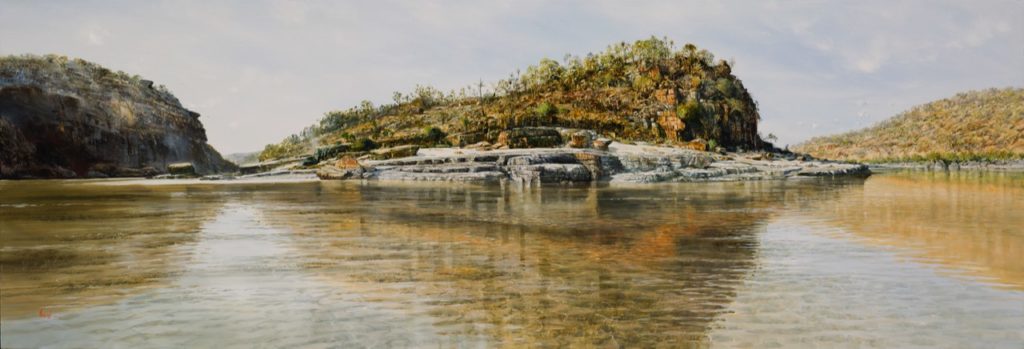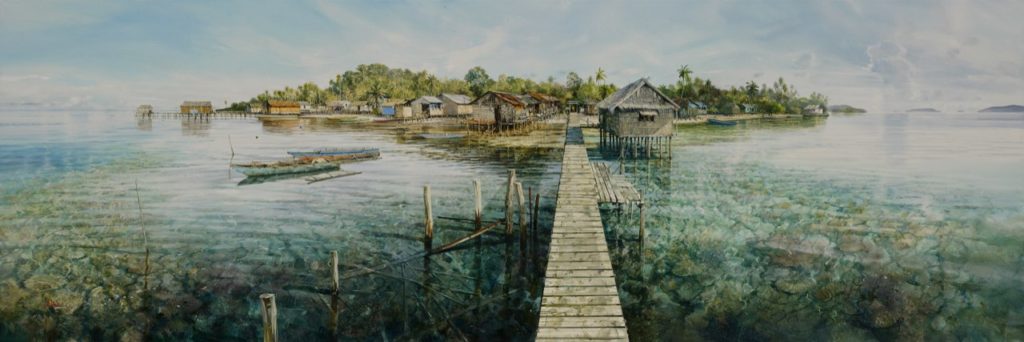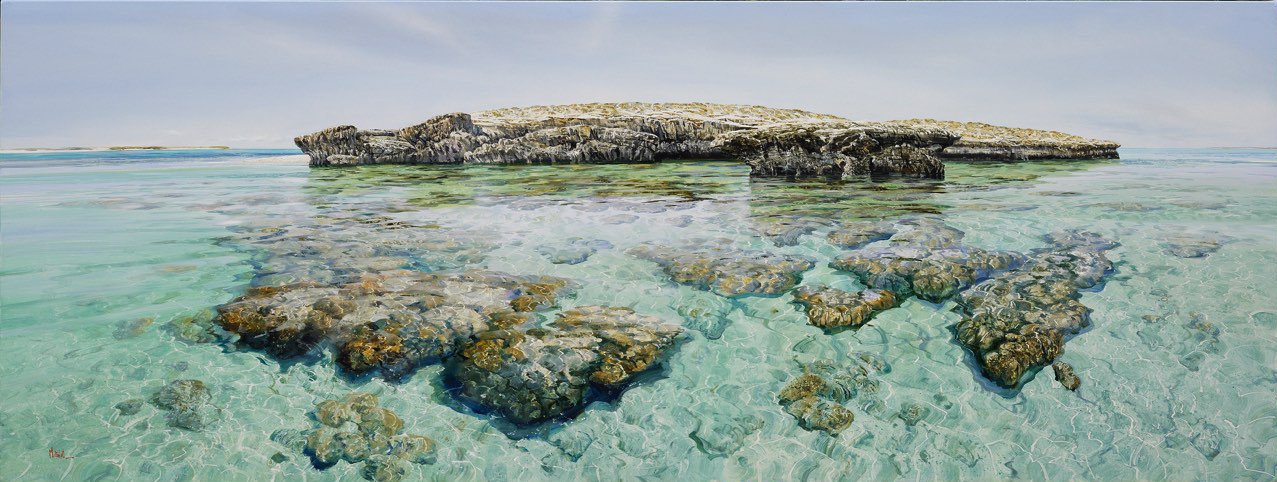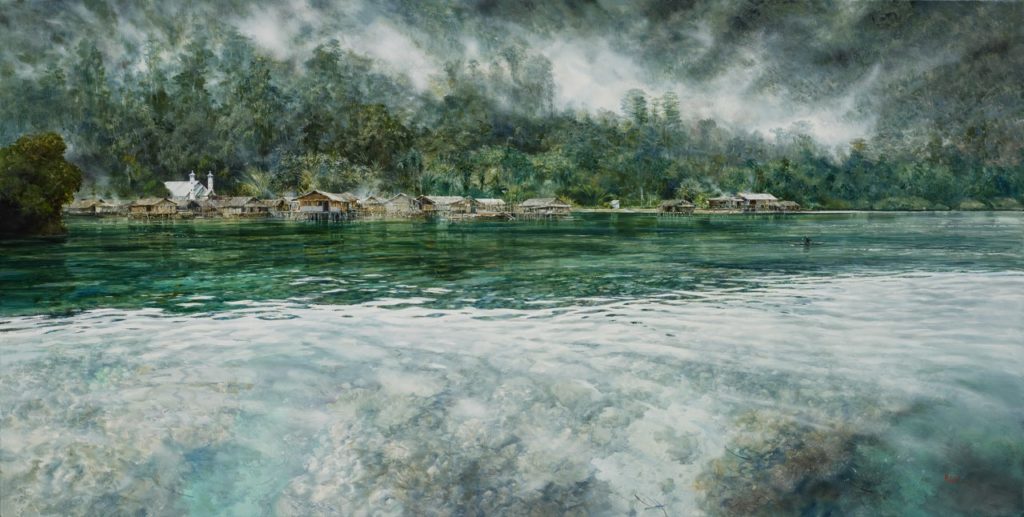The TRUE NORTH has long been a floating gallery of stunning artwork.
The cabins and day accommodation areas have featured the work of landscape painters such as Ingrid Windram, Jacinda Bayne, Andrew Tischler and Larry Mitchell.
But our relationship with Mitchell has added dimension.
Larry Mitchell is not just a revered landscape painter. He is also a man on a mission. A man committed to exhorting greater recognition of global warming and its impact on vulnerable coastal communities. And it was this mission that helped to frame a unique partnership with the TRUE NORTH
When Larry came aboard as our artist-in-residence – we quickly discovered that we shared intrinsic values and, a commitment to nourishing the communities that we encountered on our voyages together. We were pleased to provide Larry with rare access and in turn, Larry was able to chronicle in most-spectacular fashion, the great beauty of largely unchanged village life. Thereafter, Larry has used his work to highlight the menace posed by rising sea levels in international exhibitions such as The Nevada Museum project 1 Degree c.
Even without considering the ravages of climate change – the spectacular and often untouched destinations that are included in the TRUE NORTH’s sailing schedule are a constant reminder of just how fragile the environment is. And, how important it is to minimise disturbance.
Our adventure itineraries are a low impact means of accessing wilderness.
We are able to provide access without the intrusion of roads. We do not require shore-based structures. We can deliver multiple guests in a single visit and, leave no trace of our visit.
The TRUE NORTH is compliant with requirement under the MARPOL Convention – an international convention designed to minimize and eventually eliminate pollution of the sea by harmful substances. On-board waste is either processed via our treatment plant, retained for recycling or retained for disposal at an approved waste management site.
Our company is a pioneer and market leader. We are very proud of our achievements and we believe that our itineraries inspire greater appreciation of natural history. Through carefully controlled access and entertaining interpretation, we instill the importance of wilderness.
Within every itinerary we provide information on the areas that we visit. Information on culture, natural history and much more. We believe information is a critical vehicle for sharing responsibility – responsibility for maintaining wilderness for generations.
All activities are led by crew members who are trained to encourage minimal impact on the environment and we maintain a constant vigil for opportunities to nourish.
Our guests are often left humbled by the nature of our itineraries.
We are truly fortunate to showcase breathtaking destination and we hope that continued collaboration with Larry Mitchell and others like him, will help to protect the communities and lands that we visit.
THE ABROLHOS ISLANDS

Larry Mitchell – Abrolhos Islands
“Basile Island is inhabited by Italian fishermen who seem to have painted their shacks in the same beautiful colours that you might see on the Amalfi Coast. This extraordinary island is in the southern group of the Abrolhos. The TRUE NORTH goes by this group on their West Coast Explorer trip in March. I hope to be on again next year. This is my hometown, basically. I came from Geraldton originally, and these islands are 30 miles off Geraldton, where I began to bear witness to the environmental impact of climate change.”
CENDERAWASIH BAY

Larry Mitchell – Cenderawasih Bay
“Here is an island in Cenderawasih Bay, which is a big chunk out of the northern side of New Guinea. It’s where we go to view the whale sharks. There’s a small village on the side of the island. What interested me about this is that it’s an incredibly pristine neck of the woods. The oceanic environment has beautiful corals, great coral growth. If you look carefully you’ll notice that the top of the hill was being logged. There’s these little little notes of intrusion coming into the beautiful, isolated places. The nutrients are running down the hill, and of course killing the corals that are close and adjacent to the village. What looks like an idyllic tropical scene, you’ll see the first indicators of external forces. The inhabitants of this little village usually go out 200 or 300 meters in their canoes, fishing and so on. They’ve got to go further and further afield, because as soon as you get denuding of the landscape, the floral landscape, you get runoff, mineral and nutrient runoff, the same as you may in Queensland with mining activity and so on.”
LOUISIADE ARCHIPELAGO

Larry Mitchell – Eroding Island
“Palatiniain is an island in the Louisiade Archipelago, way out east of New Guinea. It’s a very isolated place in the middle of nowhere. Absolutely pollution free, not even on a shipping channel. The island’s beginning to erode away. You can see at the base of the island there, where the big trees are, the trees are starting to fall in the water. Some of these are 70-year old hardwood trees. In the middle of that island is seepage starting to come up through the middle of the island and through the coral way, underneath the sand, and some of the vegetable gardens are being polluted with salt water. Again, what looks like a tourist brochure, absolutely idyllic island, that sand spit in that only place of aerable land that you can see in that image, is beginning to be eroded away. Eventually, probably over the next decade, this village will have to shift to higher ground. This is sea level rising in action and it’s very, very evident there.”
THE KIMBERLY

Larry Mitchell – Kimberley River
“Here is a large rocky outcrop along the Kimberley Coast. I’ve looked at the Kimberley, I suppose, because I’ve looked at all of these places to see the outcomes. The Kimberley Coast is still an extremely beautiful untouched wilderness. On the coastal trip through the Kimberley with the TRUE NORTH Luxury Cruise, you see very little evidence of any kind of intrusive mining or man-made activity. Cockatoo Island is the only exception I can think of. Really, you’re looking at a quite pristine environment here in terms of the communities. I wanted to depict that because there’s a lot of pressure for the Kimberley region to become another Pilbara. That would mean industry would move and stretch up the west coast to engulf the Kimberley. My view is that the Pilbara has all the industrial infrastructure, why can’t we keep it there and contain it and leave this as a wilderness?”
WEST PAPUA

Larry Mitchell – Kris Village
“Kris Village is in West Papua, up near Raja Ampat It’s got a new jetty there you might notice, and the remnants of an old jetty. What’s interesting about this place is that the TRUE NORTH has started to visit this community to see the red bird of paradise. Just beyond this village is a great place to view these birds of paradise.”
ISLAND IN THE MONTEBELLO GROUP

Larry Mitchell – Pilbara Island
“These are very isolated limestone islands up around the Montebello group. It’s between Varanus Island and the Montebello Islands, which again, the TRUE NORTH travels up on the West Coast Explorer (cruise from Fremantle). I wanted, again, to depict the ancient limestone formations. These are very low-level islands, and in ten years’ time, they’ll be gone. These tiny low formations can be transitory things. They’re cyclic, they come and they go. This is really a depiction of the space and the cleanliness and the simplicity of these beautiful rocky outcrops.”
PILBARA ISLAND

Larry Mitchell – Pilbara Island Pilbara
“This is painting of another Pilbara Island. You can really see how close in TRUE NORTH can get because of its shallow draft. You’ll get right onto, very close to very shallow reef systems. The access TRUE NORTH offers is quite extraordinary. They also have six tenders, and a chopper, so it allows access to hard to get at places. Led by the marine scientists, Andy Lewis and people like that, there’s an education program about not damaging coral with anchor rubs, diving contact. We’re the visitors there. You can see the coral growth also at the base of the island. A great deal of concern is that you look at it, then stay away from it, to make sure there’s no damage done by our visit there.”
RAJA AMPAT

Larry Mitchell – Raja Ampat
“Wayag, in Raja Ampat of West Papua, is one of the most profoundly beautiful marine environments on the planet. This has got the highest biodiversity of marine life anywhere in the world. They are starting to see some kind of coral bleaching here now, and some of the species from the top in, for instance sharks, with shark finning and so on, are starting to deplete. Then of course, that filters down through the rest of the food chain and can create some imbalances there. Really I’m depicting the world’s marine biodiversity hot spot, acknowledging the fact that the beginnings of problems there in terms of bad fishing cultures and so on. There’s a lot of education input into this place by the Indonesian government, as well. The Indonesian government have been so environmentally proactive which is fantastic to see.”
ISLAND IN THE BISMARCK SEA

Larry Mitchell – Tiny Island
“A tiny island in the Bismarck Sea. It’s in the sea running north of Papua New Guinea and West Papua. It’s got one dwelling on it. The point is, I love the poignancy of that image in terms of the fact that it’s just a tiny dot. It’s starting to disappear from the right-hand end in that image. You can start to see the erosion. Basically, that’ll be gone in a number of years, under a decade. That island will disappear. That lonely, hermetic lifestyle will have to be taken up somewhere else.”
BINTUNI BAY

Larry Mitchell – Village on Bintui mangrove flats
“Bintuni Bay in West Papua. It’s a new village built with Indonesian money by the immigrants from Indonesia who now inhabit West Papua. You can see the remnants of old Papuan buildings underneath all that. It’s this huge long jetty that’s been built out into the bay there, through the mangroves. There’s a lot of shrimp farming and fish farming. You can see fish farming rafts and that going on here. This is all new villages with an Indonesian somewhat more industrialised thinking, influencing West Papua, which was annexed by Indonesia 50 years ago.”
YENDI VILLAGE

“This is Yendi Village at the base of a huge mountain range. You can see there’s sort of mist and smoke rising out of the jungle behind the village. Beautiful coral growth out in front of that village, and a massive church, built with Indonesian money. It’s quite an ominous village in some ways. When we went ashore there, there was quite a lot of illness. You wondered about the enormous amount of money being put into building this megalithic church when there are health issues to be addressed.
There was a lot of illegal logging going on in those forests as well. As soon as we showed up, the chainsaws were switched off, and as soon as we went, they were switched on again. There’s a lot of illegal logging going on in this area through various Asian logging companies. This is one of their favourite haunts. You really feel that the priorities are a little askew there in terms of the way that money’s being spent and the way people are being treated. There’s a lot being taken out of there without much benefit to the local people.”
Q. It seems that you’ve been involved in, you’ve had concern about environmental issues over quite a long period of time. How far back does your interest go?
It began originally around about ’86, ’87. Climate change was really quite abstract then and hardly talked about in the media. A few scientists were communicating about it, but it really wasn’t a big issue in the ’80s. I’ve spent so much time in the Abrolhos and beach-combing around Geraldton and visiting islands. I saw the physical outcomes. I’ve seen them arise.
Beaches that I’ve known since I were a kid that hadn’t changed for my 50 years were disappearing very quickly. My fishing spots I used to go to drive my 4-wheel drive onto in 1975 were gone by ’86 and ’87. They had been there my entire life. We used to camp on them when we were children. That’s how rapid change is happening. My interest came as a result of physical evidence of that change. I changed from being a contemporary artist in Britain to changing tack and putting all my energies and all my money into recording those outcomes. It’s been my whole life, actually, ever since that.
Q. What does the True North mean to you?
It’s come to mean a lot. Certainly it’s given me access to these places, which has been extraordinary. The staff and crew have been incredibly giving in terms of helping me with my project. They don’t just take me around there as a tourist. If something important in my work is going to occupy time and their resources, they’ll make them available to me. They have all the way through. Craig and Peter are friends of mine as well. We’re all from the same neck of the woods. We are all from around Geraldton.
I feel great affection towards the boat, and it’s been a real privilege to work with the crew. I feel like I’m working with them, that we’re working on something good together. I feel like they’re part of this project that I’ve been working on, and I feel part of their life and their project as well.
Photography Credit: Victor France Photographic




